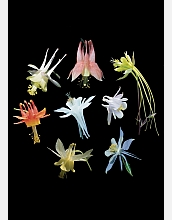News Release 07-065
Columbine Flowers Develop Long Nectar Spurs in Response to Pollinators
Research offers evidence that evolution may occur in a stop-and-go pattern

Columbine flowers are growing extra-long spurs in response to pollinators.
June 6, 2007
This material is available primarily for archival purposes. Telephone numbers or other contact information may be out of date; please see current contact information at media contacts.
In flowers called columbines, evolution of the length of nectar spurs--the long tubes leading to plants' nectar--happens in a way that allows flowers to match the tongue lengths of the pollinators that drink their nectar, biologists have found.
The researchers were Justen Whittall of the University of California at Davis and Scott Hodges of the University of California at Santa Barbara. They were funded by the National Science Foundation (NSF). Their results appear in this week's issue of the journal Nature.
Darwin once proposed a co-evolutionary "race" to explain how natural selection might account for the evolution of very long nectar spurs in flowers, said Hodges. "In Darwin's race, plants with the longest spurs and pollinators with the longest tongues [to tap the flowers' nectar] would be favored by natural selection, and--in a never-ending process--continually drive the plants' spurs and the pollinator tongues to exceptionally long lengths."
But it turns out, Whittall and Hodges found, that evolution acts in a more one-sided fashion in many plants: the plants evolve nectar spurs to match the tongue-lengths of the pollinators. Then the process stops, and only starts again when there is a change in pollinators.
Whittall and Hodges proved this idea by testing the columbine genus Aquilegia, which is pollinated by bumblebees, hummingbirds and hawkmoths.
They found that most of the columbines' nectar spur length evolution happened during shifts in pollinators from bumblebees to hummingbirds, and from hummingbirds to hawkmoths. In between these shifts, evolution of the columbines' nectar spurs came to a halt.
Whittall and Hodges' work provides evidence that evolution may occur in a stop-and-go pattern--one in which adaptation to specific pollinators occurs very rapidly, followed by periods of no further evolution until another pollinator shift occurs, according to William Zamer, deputy director of NSF's division of integrative organismal systems.
"In the case of these flowers, changes appear to happen relatively rapidly in response to changes in pollinators," said Zamer.
NSF's biocomplexity in the environment emphasis area and division of environmental biology funded the research.
-NSF-
Media Contacts
Cheryl Dybas, NSF, (703) 292-7734, email: cdybas@nsf.gov
The U.S. National Science Foundation propels the nation forward by advancing fundamental research in all fields of science and engineering. NSF supports research and people by providing facilities, instruments and funding to support their ingenuity and sustain the U.S. as a global leader in research and innovation. With a fiscal year 2023 budget of $9.5 billion, NSF funds reach all 50 states through grants to nearly 2,000 colleges, universities and institutions. Each year, NSF receives more than 40,000 competitive proposals and makes about 11,000 new awards. Those awards include support for cooperative research with industry, Arctic and Antarctic research and operations, and U.S. participation in international scientific efforts.
Connect with us online
NSF website: nsf.gov
NSF News: nsf.gov/news
For News Media: nsf.gov/news/newsroom
Statistics: nsf.gov/statistics/
Awards database: nsf.gov/awardsearch/
Follow us on social
Twitter: twitter.com/NSF
Facebook: facebook.com/US.NSF
Instagram: instagram.com/nsfgov


